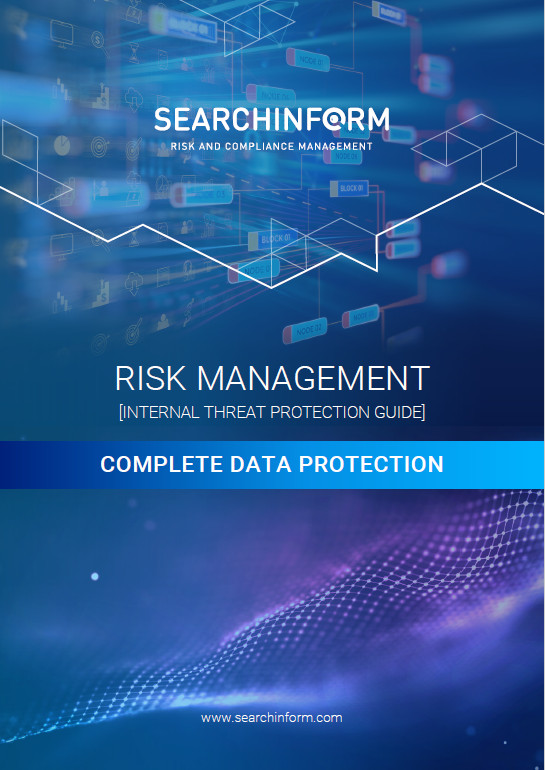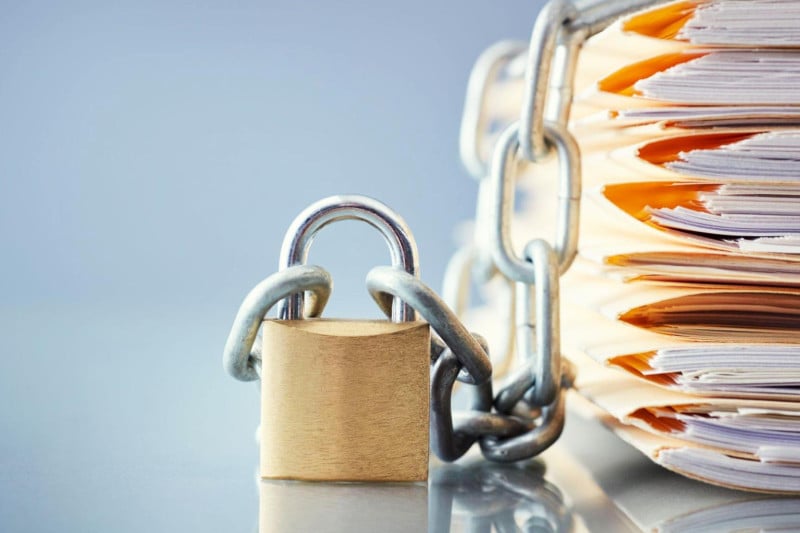Combatting Invoice Fraud: Cybersecurity Strategies for Businesses
- Understanding Invoice Fraud
- Definition of Invoice Fraud
- Common Types of Invoice Fraud
- Real-Life Examples of Invoice Fraud
- Cybersecurity and Invoice Fraud
- The Role of Cybersecurity in Preventing Invoice Fraud
- Key Cybersecurity Measures to Mitigate Invoice Fraud
- The Impact of Invoice Fraud on Businesses
- Responding to Invoice Fraud
- Steps to Take After Detecting Invoice Fraud
- Legal and Financial Implications of Invoice Fraud
- Best Practices for Preventing Invoice Fraud
- Establish Strong Internal Controls
- Use Automated Invoice Matching
- Implement Vendor Verification Procedures
- Train Employees on Recognizing Invoice Fraud
- Leverage Cybersecurity Tools
- Foster a Culture of Transparency
- Future Trends in Invoice Fraud and Cybersecurity
- Emerging Threats in Invoice Fraud
- The Evolution of Cybersecurity in Combatting Fraud
- How SearchInform Can Help
- Comprehensive Fraud Detection and Prevention
- Real-Time Alerts and Notifications
- Robust Internal Controls and Employee Monitoring
- Data Loss Prevention (DLP) Integration
- Ensuring Compliance with Financial Regulations
Understanding Invoice Fraud
Invoice fraud, also known as billing fraud or fraudulent invoicing, is an increasing threat to businesses of all sizes. It's a deceptive practice where criminals manipulate invoicing processes to siphon off funds. As organizations move towards digital transactions, the risks associated with fake invoicing have become more sophisticated, making it crucial for businesses to be vigilant.
Definition of Invoice Fraud
Invoice fraud refers to any scheme where fake invoices or billing errors are used to trick a company into making payments for goods or services that were never provided. This fraudulent activity can range from small-scale billing errors to elaborate schemes involving multiple parties, including insiders.
In a typical scenario, a fraudster submits a fake invoice to a business, posing as a legitimate supplier. The business, unaware of the deceit, processes the payment, resulting in financial losses. The manipulation of invoices can take many forms, and often these schemes are only discovered after significant damage has been done.
Common Types of Invoice Fraud
There are several ways in which invoice fraud occurs. By understanding the most common types, businesses can take steps to safeguard against these threats:
- Fake Invoices: Fraudsters create entirely fabricated invoices for goods or services that were never ordered or received. The invoice is designed to look legitimate, often mimicking a real vendor’s layout or details.
- Overbilling: This form of fraudulent invoicing occurs when vendors inflate the price of goods or services compared to the original agreement. This is often done in smaller increments to avoid detection.
- Duplicate Billing: Fraudsters may submit multiple invoices for the same service or product, knowing that payment systems are sometimes inefficient at catching duplicates.
- Phantom Vendors: Criminals set up fake companies and submit invoices to businesses. Without proper due diligence, businesses may end up paying these phantom vendors for nonexistent services.
- Account Takeover Fraud: In this scenario, cybercriminals gain access to a vendor’s account and alter payment details on an invoice, redirecting payments to fraudulent accounts.
Real-Life Examples of Invoice Fraud
Invoice fraud continues to impact businesses across various industries, with some high-profile cases illustrating the severity of the threat.
-
-
Case 1: Google and Facebook Fake Invoicing Scam
One of the most notorious cases of invoice fraud involved Google and Facebook, where a Lithuanian man, Evaldas Rimasauskas, orchestrated a fake invoicing scam that cost these tech giants over $100 million. Rimasauskas set up a fake company posing as a legitimate Asian supplier and sent fraudulent invoices to both Google and Facebook for services never provided. The companies, believing the invoices were legitimate, processed the payments, which were then wired to offshore accounts controlled by the fraudster. This case highlighted the importance of verifying vendors and invoices before approving payments. -
Case 2: Belgian Port Authorities and Duplicate Billing Scheme
In a case involving Belgian port authorities, a group of employees collaborated with external vendors to run a duplicate billing scam. The employees submitted multiple invoices for the same work, and over time, they siphoned off over €2 million from the organization. The fraud was eventually uncovered during a routine audit, but by then, the port authority had suffered substantial financial losses.
-
Case 1: Google and Facebook Fake Invoicing Scam
-
Case 3: Tech Startup Halts Billing Fraud with Real-Time Monitoring
A growing tech startup became the target of fraudulent invoicing when cybercriminals impersonated one of its regular suppliers. The fake invoicing scheme involved submitting duplicate and inflated invoices that closely mimicked legitimate transactions from the actual vendor. Fortunately, the startup had recently implemented a real-time monitoring system that flagged the unusual billing patterns and discrepancies in the invoices.
After investigating further, the finance team discovered that the supplier’s account had been compromised, and fraudulent actors had taken control to issue false invoices. By halting payments before they were processed, the startup was able to avoid a potential loss of $100,000. This incident highlighted the importance of having a real-time detection system in place to stop invoice fraud in its tracks.
These examples serve as cautionary tales for businesses to implement stringent checks and validation procedures for invoices, vendors, and billing processes. The financial and reputational damage from invoice fraud can be severe, and early detection is critical to minimize losses.
Cybersecurity and Invoice Fraud
In today’s digital era, where businesses increasingly rely on electronic transactions and automated payment systems, the risk of invoice fraud, or fraudulent invoicing, has never been higher. As cybercriminals become more adept at exploiting weaknesses in payment and invoicing processes, companies must fortify their defenses with robust cybersecurity measures. Failing to do so can result in significant financial losses, reputational damage, and compromised relationships with suppliers and customers.
The Role of Cybersecurity in Preventing Invoice Fraud
Cybersecurity plays a crucial role in detecting and preventing invoice fraud before it inflicts harm on a business. Fraudsters are continually finding new ways to deceive companies through fake invoicing schemes, using tactics like phishing emails, account takeovers, and malware to manipulate invoicing and billing systems. Without the right cybersecurity tools and protocols, businesses are left vulnerable to these attacks.
An effective cybersecurity strategy includes safeguarding internal systems from unauthorized access, ensuring that only legitimate invoices are processed and paid. This also involves verifying the authenticity of invoices and supplier accounts, as well as regularly auditing financial transactions to detect any anomalies.
Cybersecurity measures should also protect sensitive financial information from external threats, as hackers often target invoicing systems to steal vendor information and manipulate payment details. By strengthening cybersecurity protocols, businesses can better protect themselves from fake invoicing schemes, reducing the risk of falling victim to costly billing fraud.
Key Cybersecurity Measures to Mitigate Invoice Fraud
Implementing a few essential cybersecurity measures can significantly mitigate the risks associated with invoice fraud. Some of the key steps include:
- Multi-Factor Authentication (MFA): By requiring multiple forms of verification to access invoicing systems, businesses can prevent unauthorized users from submitting fake invoices or tampering with payment processes.
- Secure Payment Gateways: Using encrypted payment systems ensures that sensitive financial data is protected from potential hackers who might seek to alter invoice information.
- Vendor Verification Procedures: It’s vital to establish a robust vendor verification process before approving any invoice payments. This includes confirming that the invoice matches purchase orders and conducting background checks on new vendors to prevent fake invoicing from illegitimate companies.
- Regular Audits and Monitoring: Continuous monitoring of financial transactions and conducting regular audits can help detect fraudulent invoicing early. If there are discrepancies in billing amounts, duplicates, or unusual patterns, businesses can respond quickly and prevent further losses.
- Employee Training: Cybersecurity training for employees, especially those handling financial transactions, is essential. Staff must be aware of the signs of invoice fraud, such as phishing attempts or unsolicited invoices, and know how to report suspicious activity.
The Impact of Invoice Fraud on Businesses
The financial repercussions of invoice fraud can be severe, but the damage often extends beyond just monetary losses. When businesses fall victim to billing fraud, they risk eroding trust with their suppliers, customers, and stakeholders. A single fake invoicing incident can lead to delayed payments, strained supplier relationships, and even legal consequences if the fraud goes unchecked.
In addition, the reputational harm caused by fraudulent invoicing can be long-lasting. Customers and partners may lose confidence in a company’s ability to manage its financial processes securely. Businesses that fail to detect invoice fraud early could also face regulatory fines for non-compliance with industry standards or payment security regulations.
Moreover, the time and resources required to resolve fraudulent invoicing schemes can be considerable. Companies must invest in investigating the incident, recovering funds, and implementing stronger cybersecurity measures to prevent future occurrences. This can divert attention away from other business priorities and negatively affect operational efficiency.
By prioritizing cybersecurity and taking proactive steps to mitigate the risks of invoice fraud, businesses can protect their bottom line, preserve trust with key partners, and maintain their reputation in a highly competitive market.
Responding to Invoice Fraud
When businesses detect invoice fraud, immediate action is crucial to minimize financial losses and mitigate potential legal ramifications. Whether it's billing fraud, fake invoicing, or other forms of fraudulent invoicing, having a well-planned response can help businesses recover swiftly and prevent further occurrences. Failing to respond properly can lead to escalated financial damage, regulatory penalties, and a loss of trust among stakeholders.
Steps to Take After Detecting Invoice Fraud
Once invoice fraud has been identified, businesses must act quickly and strategically. The following steps outline a structured response that can help limit the impact of the fraudulent activity:
-
Freeze Payments Immediately
As soon as fraudulent invoicing is suspected, any outstanding payments to the suspicious vendor or account should be halted. Delaying this action increases the risk of the fraudulent payment being processed, which makes recovering funds significantly more difficult. -
Notify Internal Stakeholders
Key personnel, including finance, legal, and cybersecurity teams, should be informed immediately. This ensures that all departments are aligned in addressing the situation and can work together to conduct an internal investigation and take corrective action. -
Conduct a Thorough Investigation
Begin an internal review to trace the origin of the fraudulent invoice and understand how it bypassed existing checks. This may involve scrutinizing vendor records, analyzing payment systems, and reviewing communications with the vendor. Cybersecurity teams should assess whether there has been any breach or compromise of sensitive data. -
Engage External Experts if Necessary
In complex cases, it might be necessary to engage external forensic accountants or cybersecurity experts to conduct a deeper analysis. These experts can help track down the fraud’s origins, whether it’s internal collusion, cybercrime, or an external scheme. -
Report the Incident
Depending on the severity of the fraudulent invoicing incident, businesses may need to report it to regulatory authorities or law enforcement agencies. This step is especially crucial if the fraud involves large sums of money or if personal or financial data has been compromised. -
Strengthen Internal Controls
After the investigation is complete, it's essential to address any weaknesses in internal processes that allowed the invoice fraud to occur. Implementing more stringent financial controls, such as automated invoice matching, multi-factor authentication, and regular audits, can reduce the chances of future billing fraud.
Legal and Financial Implications of Invoice Fraud
Invoice fraud can have significant legal and financial consequences for businesses, especially if the fraud is not detected early. Understanding the potential implications can help businesses better prepare for the aftermath of fraudulent invoicing.
- Financial Losses: In cases of undetected billing fraud, businesses may suffer direct financial losses due to fraudulent payments. Additionally, the time and resources required to recover funds and resolve the issue can be substantial. Legal fees, the cost of external investigations, and system overhauls can further compound the financial impact.
- Reputation Damage: Falling victim to invoice fraud can tarnish a company’s reputation, particularly if the incident becomes public or affects business partners. Suppliers and customers may lose confidence in the organization’s ability to manage its financial processes securely, leading to strained relationships and potential loss of business.
- Legal and Regulatory Penalties: Depending on the jurisdiction and industry, businesses may face legal action or regulatory penalties if fraudulent invoicing is linked to a lack of compliance with financial regulations. Failing to report incidents of fraud may also lead to sanctions or fines from regulatory bodies.
- Contractual Disputes: Invoice fraud can result in disputes between companies and their vendors or customers. In cases where a fraudulent invoice leads to the cancellation of legitimate payments, businesses may find themselves entangled in legal disputes over breached contracts or missed payments.
- Potential for Cybersecurity Breaches: In many cases, fake invoicing schemes are tied to broader cybersecurity breaches. Criminals may have gained access to sensitive financial data or customer information, leading to further liabilities, including legal claims from affected parties or mandatory notifications under data protection laws.
By addressing invoice fraud swiftly and thoroughly, businesses can limit the financial and legal implications, maintain trust with stakeholders, and strengthen their defenses against future threats.

Best Practices for Preventing Invoice Fraud
Invoice fraud, including billing fraud and fake invoicing, can have devastating consequences for businesses, draining financial resources and damaging reputations. In earlier sections, we touched upon several practices that can help mitigate fraudulent invoicing, but here, we'll explore these strategies in more detail. Preventing invoice fraud requires a combination of strategic planning, technology, and human vigilance. Implementing the following best practices will not only safeguard against fake invoicing but also strengthen overall financial security.
Establish Strong Internal Controls
Previously, we mentioned the importance of internal controls in combating invoice fraud. Let’s dive deeper into how these controls function. Strong internal controls are the backbone of financial security, providing essential checks and balances:
- Segregation of Duties: By ensuring that no single employee controls both payment authorization and invoice approval, businesses reduce the risk of internal billing fraud. The more personnel involved in the payment process, the harder it becomes for fraudulent invoicing to go unnoticed.
- Approval Hierarchies: We've highlighted the necessity of approval hierarchies before, but here’s why they're critical. Requiring multiple levels of approval for invoices before payment prevents errors and fraud by ensuring that each invoice is scrutinized by multiple eyes.
- Regular Audits: Conducting routine internal and external audits was briefly mentioned earlier. Audits are vital as they help detect discrepancies in billing and identify fake invoicing schemes before they cause significant financial damage.
Use Automated Invoice Matching
Automation is an essential tool previously mentioned in the context of invoice fraud prevention, and here’s how it works in detail. Automated invoice matching systems compare invoices against purchase orders and delivery receipts in real time, minimizing human error and fraud risk. These systems:
- Ensure that only verified invoices are processed
- Automatically flag duplicate, suspicious, or inflated invoices
- Streamline approval processes to maintain accuracy and reduce the chance of paying fraudulent invoices
Implement Vendor Verification Procedures
We earlier touched on the necessity of vendor verification, but it’s worth expanding on the process. Ensuring that all vendors are legitimate before processing payments is crucial in avoiding fake invoicing schemes. Here are additional details on how to properly verify vendors:
- Vendor Onboarding Process: A formal onboarding process includes verifying business credentials, confirming banking details, and cross-referencing tax identification numbers. This makes it harder for fraudsters to infiltrate your payment system with fake invoices.
- Maintaining an Approved Vendor List: As mentioned earlier, having an updated list of verified vendors ensures that invoices from unverified sources are flagged. This simple measure greatly reduces the risk of fraudulent invoicing.
- Direct Vendor Communication: In cases where there are changes in payment details, always verify these changes directly with the vendor to prevent falling for scams where fraudsters impersonate legitimate suppliers.
Train Employees on Recognizing Invoice Fraud
We briefly discussed employee training, but let’s take a deeper look. Employees often represent the first line of defense against billing fraud, and proper training can make all the difference. Effective training programs should:
- Highlight Red Flags: Teach employees to recognize common warning signs such as unfamiliar vendors, unusual payment requests, and discrepancies in invoice details.
- Provide Phishing Awareness: Many fake invoicing schemes start with phishing attempts. By educating staff about phishing tactics and how to avoid them, businesses can further reduce their exposure to fraudulent invoicing.
- Escalation Protocols: It's important that employees know exactly what steps to take when they suspect invoice fraud. This includes how to report suspicious invoices and the proper channels for escalating concerns.
Leverage Cybersecurity Tools
We previously mentioned the importance of cybersecurity in preventing invoice fraud. Now, let’s explore the specific tools and methods that can be employed to prevent fraudulent invoicing:
- Multi-Factor Authentication (MFA): MFA was touched upon earlier, but here’s why it’s indispensable. By requiring users to verify their identity with two or more credentials, businesses can prevent unauthorized access to invoicing and payment systems.
- Real-Time Monitoring: Advanced monitoring tools provide continuous oversight of financial transactions, detecting suspicious activities such as fake invoicing in real time. This allows businesses to take immediate action before the fraud escalates.
- Data Encryption: Encrypting sensitive financial data ensures that even if a hacker gains access to your system, they cannot use the information to carry out billing fraud or fake invoicing.
Foster a Culture of Transparency
Earlier, we mentioned the importance of transparency in preventing internal fraud. Here’s how fostering a transparent work environment can act as a powerful deterrent against invoice fraud:
- Open Communication: Encourage employees to report any suspicious activities without fear of retaliation. Transparency within the organization promotes accountability, making it harder for fraudulent invoicing schemes to go unnoticed.
By implementing these best practices, businesses can stay ahead of invoice fraud, billing fraud, and fake invoicing schemes. Addressing these practices in more detail not only enhances overall financial security but also fortifies a company’s defenses against evolving fraud tactics.
Future Trends in Invoice Fraud and Cybersecurity
As technology evolves, so do the tactics used by fraudsters. Invoice fraud, including billing fraud and fake invoicing, continues to adapt, with criminals developing new strategies to exploit vulnerabilities in business systems. To stay ahead of these emerging threats, businesses must also adapt, ensuring their cybersecurity measures are up to date and capable of preventing sophisticated fraudulent invoicing schemes. The future landscape of invoice fraud presents both challenges and opportunities for growth in cybersecurity practices.
Emerging Threats in Invoice Fraud
The world of invoice fraud is constantly shifting as fraudsters leverage cutting-edge technology to create more advanced schemes. Businesses must remain vigilant to identify emerging threats and protect themselves from new forms of billing fraud and fake invoicing. Some of the key trends to watch include:
- AI-Driven Invoice Fraud: With the growing use of artificial intelligence, fraudsters can now create fake invoices that are nearly indistinguishable from legitimate ones. Using AI, criminals can replicate vendor layouts, logos, and formatting styles, making it harder for businesses to detect fraudulent invoicing at first glance. This sophistication demands an equally advanced response from cybersecurity tools.
- Deepfake Technology in Billing Fraud: Fraudsters are beginning to use deepfake technology to impersonate vendors or senior executives, providing false authorization for fraudulent invoices. With deepfakes, criminals can mimic voices and video calls, making it more difficult for employees to detect fraud through traditional verification methods.
- Ransomware Attacks Targeting Invoice Systems: Ransomware attacks are becoming increasingly common, and invoice systems are prime targets. Cybercriminals can freeze invoicing processes and demand ransom in exchange for unlocking vital financial data. In these scenarios, businesses are not only at risk of paying fraudulent invoices but also of losing access to crucial financial records.
- Supply Chain Fraud: As businesses become more interconnected, the risk of supply chain fraud, including fake invoicing, grows. Criminals exploit weak links within the supply chain, manipulating invoices or creating fictitious vendors to funnel payments. This evolving threat emphasizes the need for robust cybersecurity measures that extend beyond a single organization and encompass entire supply chains.
The Evolution of Cybersecurity in Combatting Fraud
As invoice fraud evolves, so must the cybersecurity solutions designed to combat it. The future of cybersecurity lies in creating systems that can adapt to increasingly complex fraud schemes. To keep pace with the rising sophistication of billing fraud, businesses need to embrace innovative technologies and strategies.
- AI and Machine Learning for Fraud Detection: Just as fraudsters are using AI, cybersecurity professionals are turning to artificial intelligence and machine learning to detect fraudulent invoicing patterns. AI-driven tools can analyze vast amounts of data in real time, flagging suspicious invoice activity, such as duplicate invoices or unusually large payments, before the fraud is completed. Machine learning algorithms learn from past fraud cases, becoming more effective over time in identifying fake invoicing schemes.
- Blockchain for Securing Financial Transactions: Blockchain technology offers a decentralized and transparent solution for preventing billing fraud. By using blockchain, every invoice and payment is recorded in an immutable ledger, making it nearly impossible for fraudsters to alter or fake invoicing data. Blockchain can enhance the integrity of financial systems and provide real-time verification of transactions, reducing the likelihood of fraudulent invoices being processed.
- Cloud-Based Security Solutions: As businesses migrate to cloud-based financial systems, cybersecurity must adapt accordingly. Cloud-based security solutions can provide real-time monitoring and instant updates to counter emerging threats. These systems also offer advanced encryption techniques, ensuring that sensitive financial information is protected from hackers attempting to inject fake invoices into the payment system.
- Zero-Trust Security Models: A zero-trust approach to cybersecurity is increasingly being adopted to combat billing fraud. This model assumes that no user or system can be fully trusted, and every access point is continuously verified. By requiring multiple layers of authentication and constantly monitoring user behavior, businesses can detect and prevent unauthorized access to invoicing systems, minimizing the risk of fraudulent invoicing.
- Predictive Analytics and Behavior Monitoring: Predictive analytics is becoming a critical tool for businesses in identifying invoice fraud before it happens. By analyzing historical invoicing data and monitoring user behavior, these tools can predict when and where fraud is most likely to occur. Companies can use this insight to bolster their defenses, flagging potential billing fraud schemes early and preventing fake invoices from being paid.
As the battle between fraudsters and cybersecurity evolves, businesses must remain proactive. Keeping up with the latest trends in invoice fraud and adopting emerging cybersecurity technologies will be essential in safeguarding financial systems against increasingly sophisticated threats.
How SearchInform Can Help
In today’s fast-paced business environment, the threat of invoice fraud is ever-present. Billing fraud, fake invoicing, and fraudulent invoicing schemes have become more sophisticated, requiring businesses to adopt equally advanced solutions to safeguard their financial operations. This is where SearchInform steps in, offering powerful tools designed to detect, prevent, and respond to invoice fraud with precision and efficiency.
Comprehensive Fraud Detection and Prevention
SearchInform provides an array of tools that work together to detect fraudulent invoicing at its earliest stages, reducing the risk of financial loss. With a focus on automation and real-time monitoring, SearchInform helps businesses identify and block fake invoicing attempts before they can compromise the company’s bottom line.
- Automated Invoice Monitoring: SearchInform’s automated monitoring systems continuously scan incoming invoices, cross-referencing them with purchase orders and delivery receipts. This automated verification process ensures that discrepancies, such as duplicate or inflated invoices, are flagged immediately, preventing billing fraud from slipping through the cracks.
- Advanced Pattern Recognition: Using sophisticated algorithms, SearchInform can identify patterns that are common in fraudulent invoicing schemes. Whether it’s spotting unusually high invoice amounts or recognizing irregular billing frequencies, the platform quickly identifies red flags, allowing businesses to take swift action.
Real-Time Alerts and Notifications
SearchInform goes beyond detection by providing real-time alerts whenever suspicious billing activity is detected. The system is equipped to notify key personnel the moment it encounters potentially fraudulent invoicing, ensuring that the issue is addressed promptly before any payments are made.
- Immediate Response: With real-time alerts, businesses can respond to billing fraud attempts immediately, halting any payments associated with fake invoicing. This rapid response reduces the chance of funds being lost or misdirected due to fraudulent schemes.
- Customizable Alerts: SearchInform allows businesses to customize alerts based on their specific needs. Whether a company wants to monitor all high-value invoices or focus on invoices from new vendors, the system can be tailored to provide the most relevant notifications to the right people.
Robust Internal Controls and Employee Monitoring
Internal fraud is a growing concern for many businesses, and fraudulent invoicing often involves insider collaboration. SearchInform offers tools to strengthen internal controls, ensuring that no unauthorized personnel can manipulate billing or invoicing processes.
- Segregation of Duties Monitoring: SearchInform tracks who has access to sensitive financial data and ensures that no single employee has complete control over invoice approval and payment. This segregation of duties reduces the likelihood of internal billing fraud.
- Employee Behavior Analysis: The platform also includes behavior monitoring tools that track employee activity within financial systems. If an employee’s actions suggest potential involvement in fake invoicing schemes, SearchInform can alert management to investigate further.
Data Loss Prevention (DLP) Integration
SearchInform’s solutions seamlessly integrate with the company’s Data Loss Prevention (DLP) tools, offering businesses a holistic approach to financial security. By combining fraud detection with DLP, SearchInform ensures that sensitive financial data is protected from both internal and external threats.
- Protecting Vendor and Financial Data: SearchInform’s DLP tools safeguard sensitive financial information, such as vendor payment details and company financial records, from unauthorized access or leaks. This added layer of protection reduces the risk of hackers using compromised data to create fraudulent invoices.
- Comprehensive Data Encryption: All financial data processed through SearchInform’s platform is encrypted, ensuring that even if a breach occurs, the data remains unusable to cybercriminals.
Ensuring Compliance with Financial Regulations
Compliance with financial regulations is critical in preventing invoice fraud, as non-compliance can lead to fines or legal consequences. SearchInform’s tools help businesses maintain compliance with industry standards by providing detailed audit trails and financial transparency.
- Audit-Ready Reports: SearchInform generates detailed reports on all invoice and payment activities, making it easy for businesses to meet regulatory requirements. These reports can also be used during internal audits to ensure that no fraudulent invoicing has occurred.
- Regulatory Compliance Monitoring: SearchInform continuously monitors changes in financial regulations, ensuring that businesses are always in compliance. This proactive approach helps companies avoid penalties while maintaining secure billing processes.
SearchInform’s comprehensive approach to detecting and preventing invoice fraud, combined with its advanced cybersecurity tools, makes it an essential partner for businesses looking to safeguard their financial operations. By leveraging automation, real-time alerts, and robust internal controls, SearchInform ensures that fraudulent invoicing schemes are stopped in their tracks, protecting your business from unnecessary losses.
Take control of your business’s financial security with SearchInform’s advanced tools to detect and prevent invoice fraud. Safeguard your company from billing fraud and ensure your financial processes are protected against evolving threats with our comprehensive solutions.
Extend the range of addressed challenges with minimum effort
Company news
SearchInform uses four types of cookies as described below. You can decide which categories of cookies you wish to accept to improve your experience on our website. To learn more about the cookies we use on our site, please read our Cookie Policy.
Necessary Cookies
Always active. These cookies are essential to our website working effectively.
Cookies does not collect personal information. You can disable the cookie files
record
on the Internet Settings tab in your browser.
Functional Cookies
These cookies allow SearchInform to provide enhanced functionality and personalization, such as remembering the language you choose to interact with the website.
Performance Cookies
These cookies enable SearchInform to understand what information is the most valuable to you, so we can improve our services and website.
Third-party Cookies
These cookies are created by other resources to allow our website to embed content from other websites, for example, images, ads, and text.
Please enable Functional Cookies
You have disabled the Functional Cookies.
To complete the form and get in touch with us, you need to enable Functional Cookies.
Otherwise the form cannot be sent to us.

Subscribe to our newsletter and receive a bright and useful tutorial Explaining Information Security in 4 steps!

Subscribe to our newsletter and receive case studies in comics!







